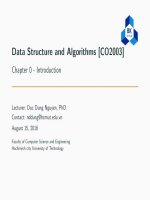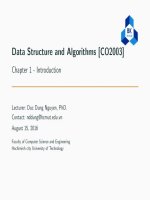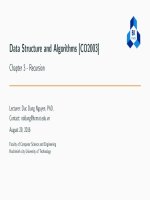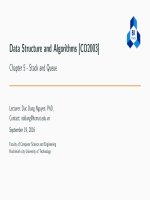C++ programming program design including data structure 7th ch20
Bạn đang xem bản rút gọn của tài liệu. Xem và tải ngay bản đầy đủ của tài liệu tại đây (627.73 KB, 44 trang )
Chapter 20:
Graphs
Objectives
•
In this chapter, you will:
–
–
–
–
–
–
–
Learn about graphs
Become familiar with the basic terminology of graph theory
Discover how to represent graphs in computer memory
Explore graphs as ADTs
Examine and implement various graph traversal algorithms
Learn how to implement the shortest path algorithm
Examine and implement the minimal spanning tree algorithm
C++ Programming: Program Design Including Data Structures, Seventh Edition
2
Introduction
•
Königsberg bridge problem:
–
The river Pregel flows around the island Kneiphof and then divides into two branches
C++ Programming: Program Design Including Data Structures, Seventh Edition
3
Introduction (cont’d.)
•
Starting at one land area, can you cross all bridges
exactly once and return to the start?
–
In 1736, Euler represented the problem as a graph
and answered the question: No
C++ Programming: Program Design Including Data Structures, Seventh Edition
4
Introduction (cont’d.)
•
Over the past 200 years, graph theory has been applied to a variety of problems, including:
•
•
Model electrical circuits, chemical compounds, highway maps, etc.
Analysis of electrical circuits, finding the shortest route, project planning, linguistics, genetics, social
science, etc.
C++ Programming: Program Design Including Data Structures, Seventh Edition
5
Graph Definitions and Notations
•
•
•
a ∈ X: a is an element of the set X
Subset (Y ⊆ X): every element of Y is also an element of X
Intersection (A ∩ B): contains all the elements in A and B
–
•
A ∩ B = {x | x ∈ A and x ∈ B}
Union (A ∪ B): set of all the elements that are in A or in B
–
A ∪ B = {x | x ∈ A or x ∈ B}
C++ Programming: Program Design Including Data Structures, Seventh Edition
6
Graph Definitions and Notations (cont’d.)
•
A × B: set of all the ordered pairs of elements of A and B
–
•
A × B = {(a, b) | a ∈ A, b ∈ B}
Graph G: G = (V, E)
–
–
–
–
V is a finite nonempty set of vertices of G
E⊆V×V
Elements in E are the pairs of elements of V
E is called set of edges
C++ Programming: Program Design Including Data Structures, Seventh Edition
7
Graph Definitions and Notations (cont’d.)
•
•
•
Directed graph or digraph: elements of E(G) are ordered pairs
Undirected graph: elements not ordered pairs
If (u, v) is an edge in a directed graph
–
–
•
Origin: u
Destination: v
Subgraph H of G: if V(H) ⊆ V(G) and E(H) ⊆ E(G)
•
Every vertex and edge of V is in G
C++ Programming: Program Design Including Data Structures, Seventh Edition
8
Graph Definitions and Notations (cont’d.)
C++ Programming: Program Design Including Data Structures, Seventh Edition
9
Graph Definitions and Notations (cont’d.)
C++ Programming: Program Design Including Data Structures, Seventh Edition
10
Graph Definitions and Notations (cont’d.)
•
•
Adjacent: there is an edge from one vertex to the other; i.e., (u, v) ∈ E(G)
Incident: if edge e = (u, v) then e is incident on u and v
–
•
•
Loop: edge incident on a single vertex
Parallel edges: associated with the same pair of vertices
Simple graph: has no loops or parallel edges
C++ Programming: Program Design Including Data Structures, Seventh Edition
11
Graph Definitions and Notations (cont’d.)
•
Path: sequence of vertices u1, u2, ..., un such that u = u1, un = v, and (ui, ui + 1) is an edge
for all i = 1, 2, ..., n − 1
•
•
•
Connected vertices: there is a path from u to v
Simple path: path in which all vertices, except possibly the first and last, are distinct
Cycle: simple path in which the first and last vertices are the same
C++ Programming: Program Design Including Data Structures, Seventh Edition
12
Graph Definitions and Notations (cont’d.)
•
Connected: path exists from any vertex to any other vertex
–
•
Component: maximal subset of connected vertices
In a connected graph G, if there is an edge from u to v, i.e., (u, v) ∈ E(G), then u is adjacent
to v and v is adjacent from u
•
Strongly connected: any two vertices in G are connected
C++ Programming: Program Design Including Data Structures, Seventh Edition
13
Graph Representation
•
To write programs that process and manipulate graphs
–
•
Must store graphs in computer memory
A graph can be represented in several ways:
–
–
Adjacency matrices
Adjacency lists
C++ Programming: Program Design Including Data Structures, Seventh Edition
14
Adjacency Matrix
•
G: graph with n vertices (n > 0)
–
V(G) = {v1, v2, ..., vn}
•
Adjacency matrix (AG of G): two-dimensional n × n matrix such that:
•
Adjacency matrix of an undirected graph is symmetric
C++ Programming: Program Design Including Data Structures, Seventh Edition
15
Adjacency Lists
•
G: graph with n vertices (n > 0)
–
•
V(G) = {v1, v2, ..., vn}
Linked list corresponding to each vertex, v,
–
–
Each node of linked list contains the vertex, u, such that (u,v) ∈ E(G)
Each node has two components, such as vertex and link
C++ Programming: Program Design Including Data Structures, Seventh Edition
16
Adjacency Lists (cont’d.)
C++ Programming: Program Design Including Data Structures, Seventh Edition
17
Operations on Graphs
•
Operations commonly performed on a graph:
–
–
Create the graph
Clear the graph
•
–
–
–
Makes the graph empty
Determine whether the graph is empty
Traverse the graph
Print the graph
C++ Programming: Program Design Including Data Structures, Seventh Edition
18
Operations on Graphs (cont’d.)
•
The adjacency list (linked list) representation:
–
For each vertex, v, vertices adjacent to v are stored in linked list associated with v
•
–
In a directed graph, vertices adjacent to v are called immediate successors
To manage data in a linked list, use class unorderedLinkedList
C++ Programming: Program Design Including Data Structures, Seventh Edition
19
Graphs as ADTs
•
We implement graphs as an abstract data type (ADT), including functions to:
–
–
–
–
Create/clear the graph
Print the graph
Traverse the graph
Determine the graph’s size
C++ Programming: Program Design Including Data Structures, Seventh Edition
20
Graph Traversals
•
Traversing a graph is similar to traversing a binary tree, except that:
–
–
•
A graph might have cycles
Might not be able to traverse the entire graph from a single vertex
Most common graph traversal algorithms:
–
–
Depth first traversal
Breadth first traversal
C++ Programming: Program Design Including Data Structures, Seventh Edition
21
Depth First Traversal
•
Depth first traversal at a given node, v:
–
–
–
Mark node v as visited
Visit the node
for each vertex u adjacent to v
if u is not visited
start the depth first traversal at u
•
This is a recursive algorithm
C++ Programming: Program Design Including Data Structures, Seventh Edition
22
Depth First Traversal (cont’d.)
•
Depth-first ordering of vertices:
–
•
0, 1, 4, 3, 2, 5, 7, 8, 6, 9
Breadth-first ordering of vertices:
–
0, 1, 3, 4, 2, 5, 7, 8, 6, 9
C++ Programming: Program Design Including Data Structures, Seventh Edition
23
Breadth First Traversal
•
Breadth first traversal of a graph
–
–
•
Nodes at each level are visited from left to right
Starting at the first vertex, the graph is traversed as much as possible
–
•
Similar to traversing a binary tree level by level
Then go to next vertex not yet visited
Use a queue to implement the breadth first search algorithm
C++ Programming: Program Design Including Data Structures, Seventh Edition
24
Shortest Path Algorithm
•
•
•
Weight of the edge: nonnegative real number assigned to the edges connecting two vertices
Weighted graph: every edge has a nonnegative weight
Weight of the path P
–
–
•
Sum of the weights of all edges on the path P
Also called the weight of v from u via P
Source: starting vertex in the path
C++ Programming: Program Design Including Data Structures, Seventh Edition
25









